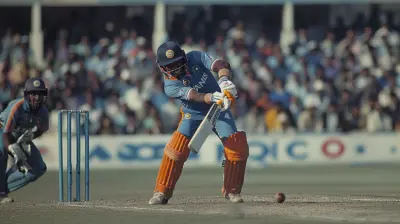Breaking Down the Most Iconic Moments in Major League History
8 August 2025
Baseball isn’t just America’s pastime – it's a canvas where legends are painted, one pitch at a time. Over the decades, Major League Baseball (MLB) has gifted us with jaw-dropping moments that are stitched into the fabric of sports history. From nail-biting walk-offs to jaw-dropping comebacks, the game has delivered unforgettable drama that still gives fans goosebumps.
So, grab your peanuts and Cracker Jack – let’s walk through the most iconic moments in MLB history, one inning at a time.![]()
Babe Ruth’s “Called Shot” – 1932 World Series
Let’s kick things off with a legend. Picture this: Game 3 of the 1932 World Series. The Chicago Cubs are playing the New York Yankees at Wrigley Field. Babe Ruth steps up to the plate, and in a moment that's both myth and magic, he points toward center field.Was he calling his shot or just gesturing at the pitcher? We may never really know for sure. But what’s not up for debate? The next pitch sailed over the fence, landing exactly where he pointed. Boom. Home run. Crowd stunned. And baseball folklore was born.
Ruth didn’t just hit a homer – he swung his way into immortality.![]()
Jackie Robinson Breaks the Color Barrier – 1947
Some moments aren’t about stats or scoreboards. When Jackie Robinson stepped onto the field for the Brooklyn Dodgers in 1947, he did something bigger than baseball – he changed the game and the country.Facing racist jeers, constant scrutiny, and untold pressure, Robinson remained composed and determined. His successful rookie season cracked open the doors of integration in sports. That moment was more than iconic – it was a symbol of courage and progress. Robinson wore number 42 with pride, and today, no player will ever wear it again. MLB retired his number across all teams – a powerful tribute to a true trailblazer.![]()
Willie Mays’ "The Catch" – 1954 World Series
Think about the greatest catches in sports history. Odds are, Willie Mays’ over-the-shoulder snag in the 1954 World Series tops the list.In Game 1 between the New York Giants and Cleveland Indians, Vic Wertz smashed a deep fly ball to center. Most players would’ve waved goodbye and jogged back to the dugout. Not Willie.
He sprinted, back to the plate, never taking his eyes off the ball, and boom – glove up, catch made, run-saving play executed like a ballet on the grass. It wasn’t just a defensive gem. It was pure athletic poetry.![]()
Bill Mazeroski’s Walk-Off Home Run – 1960 World Series
Walk-off home runs are the stuff of backyard dreams. But Bill Mazeroski made that dream real in Game 7 of the 1960 World Series.Tied 9-9 in the bottom of the ninth against the powerhouse Yankees, Mazeroski of the Pittsburgh Pirates stepped into the box. He sent a rocket over the left-field wall, sealed the championship, and etched his name into history.
To this day, it's the only walk-off home run to win a Game 7 in the Fall Classic. That’s not just clutch – that’s legendary.
Hank Aaron Breaks Babe Ruth’s Home Run Record – 1974
714. That was Babe Ruth’s home run total, a number so iconic it felt untouchable – until 1974.Hank Aaron, playing for the Atlanta Braves, stepped up to the plate with 713 homers under his belt. On April 8th, in front of a packed house (and millions watching on TV), Aaron made contact and sent No. 715 into the clouds.
As he rounded the bases, two fans ran alongside him – not to tackle, but to celebrate. It wasn’t just a record; it was a triumph over racism, death threats, and unimaginable pressure. Aaron showed the world what grace under fire really looked like.
Kirk Gibson’s Pinch-Hit Home Run – 1988 World Series
Let’s set the scene: Game 1. Dodgers vs. A’s. Kirk Gibson, battling injuries in both legs, is barely able to walk. No one expects him to play – let alone bat.But ninth inning, down one, Gibson limps out of the dugout. Facing dominant closer Dennis Eckersley, the count goes full.
And then boom. He launches a two-run homer into the right field seats. Gibson pumps his arm in that now-legendary fist pump as he hobbles around the bases.
It was Hollywood-level drama – and it was real. It may have been a swing, but it felt like a miracle.
Cal Ripken Jr. Breaks the Consecutive Games Record – 1995
In an era of load management and rest days, Cal Ripken Jr.'s ironman streak feels superhuman. For 2,131 straight games, he took the field. Day in, day out.On September 6, 1995, he passed Lou Gehrig’s longstanding record, and the baseball world stopped to salute him. Baltimore fans gave him a standing ovation that lasted over 20 minutes.
Ripken didn’t just show durability – he showed reliability. He showed what it means to show up, no matter what.
The 2004 Red Sox Comeback – ALCS vs. Yankees
Boston fans waited 86 years to break the “Curse of the Bambino.” And when they finally did it, they did it with style.Down 3-0 in the ALCS to their hated rivals, the New York Yankees, the Red Sox staged the greatest comeback in baseball history. No MLB team had ever come back from 3-0 in a series. But Boston had belief, and they had heroes like David Ortiz.
Game after game, they clawed their way back – extra innings wins, clutch hits, brilliant pitching. Four straight wins later, they flipped the script and went on to sweep the Cardinals in the World Series.
That wasn’t just baseball – that was redemption.
Derek Jeter’s “Mr. November” Walk-Off – 2001 World Series
The 2001 World Series between the Yankees and Diamondbacks had its share of thrills. But Derek Jeter added something extra: timing.Game 4 went past midnight into November – pushing baseball’s calendar past its usual limits due to the season delay from 9/11.
With a tied game and the clock flipping to a new month, Jeter stepped up and delivered a walk-off homer. The crowd erupted. Broadcasters dubbed him “Mr. November” on the spot.
It was a chill-inducing moment in a World Series that carried heavy emotional weight for the nation.
Barry Bonds Hits Home Run No. 756 – 2007
Say what you will about the controversy – but there’s no denying Barry Bonds’ place in the record books.In 2007, Bonds passed Hank Aaron with his 756th career homer. It was a towering shot at AT&T Park that landed in a sea of pumped-up fans.
The moment was historic – a culmination of years of dominance at the plate. Love him or not, Bonds was a hitting machine, and No. 756 meant he was alone atop baseball’s most sacred list.
Chicago Cubs Win the World Series – 2016
Let’s be honest: the Cubs were the lovable losers for over a century. But in 2016, something shifted.After 108 long years, Chicago finally tasted glory. And they didn’t make it easy. Game 7 of the World Series against Cleveland went 10 innings, with rain delays and enough twists to make your heart skip.
Then, with a clutch hit by Ben Zobrist and a tight rope ninth inning, the Cubs sealed the deal.
Chicago cried. Fans embraced. Even casual baseball lovers felt that wave of joy. It wasn’t just a win – it was a century-old burden lifted.
Shohei Ohtani’s Two-Way Brilliance – Present Day
Let’s not forget about the present.Shohei Ohtani is a modern marvel: a pitcher who can hit like a cleanup slugger. Not since Babe Ruth have we seen a player dominate both sides of the ball like this.
He’s throwing 100 mph gas on the mound and launching 450-foot bombs at the plate. Are we sure he's even human?
Watching Ohtani is like watching a video game come to life. Every time he takes the field, history could happen. And honestly? It usually does.
Why These Moments Matter
Baseball is more than just stats and standings. It's about the people, the pressure, the impossible turned possible. These iconic MLB moments stick with us not just because they happened – but because of how they made us feel.They made us believe. They made us dream. And most of all, they reminded us why we fell in love with the game in the first place.
So the next time you’re watching a regular season game in June, remember this: any pitch, any swing, any play could become the next moment we talk about for decades.
Final Thoughts
Baseball has never been just a sport. It’s a living memory bank – filled with stories that grandparents pass down, moments that freeze time, and players who remind us that greatness can arrive at any moment.Whether it’s Babe Ruth pointing, Jackie Robinson persevering, or Shohei Ohtani redefining what’s possible, the magic of Major League Baseball is that its next iconic moment is always just around the corner.
So keep your eyes on the field. The next chapter is being written right now.
all images in this post were generated using AI tools
Category:
Sports LeaguesAuthor:

Preston Wilkins
Discussion
rate this article
1 comments
Amos Roberts
Iconic moments? Please. If we're not talking about the unforgettable blunders too, like that time a ball boy became the real MVP by accidentally stealing the spotlight, then we're missing half the fun. History is made in the glory AND the cringe—embrace the chaos, folks!
September 1, 2025 at 3:23 AM

Preston Wilkins
Absolutely! It’s the mix of brilliance and blunders that makes sports so captivating. Embracing both the glory and the cringe truly highlights the unpredictability of the game!


